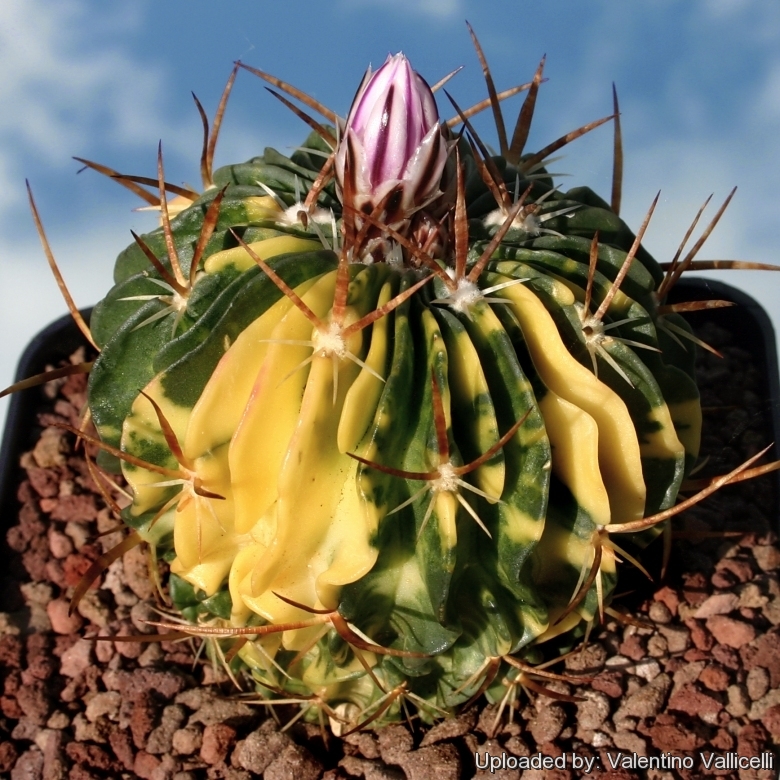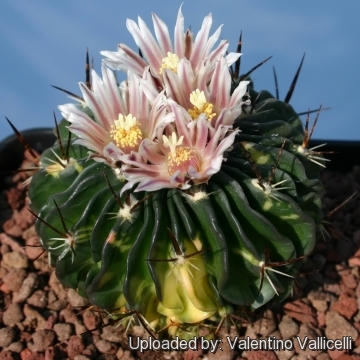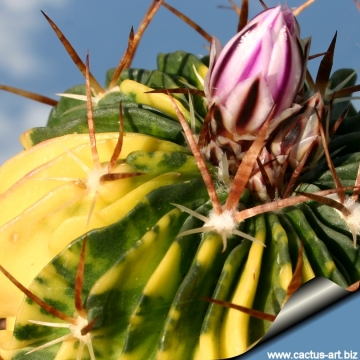Accepted Scientific Name: Stenocactus sp. (hybrids) f. variegatus hort.

Echinofossulocactus sp. (hybrid) f. variegatus (Stenocactus sp. (hybrids) f. variegatus) Photo by: Valentino Vallicelli
Origin and Habitat: Garden origin.
Synonyms:
Description: Some of the most intriguing Stenocactus (Echinofossulocactus) cultivars are the result of careful (or casual) cross-breeding, and possess unique and attractive characteristics. That is why hybrid seeds are easy to obtain as most of the species are easy to cross, and their seeds have a high germination capacity that lasts for 2 years. Multi hybrids generally display an exclusive combination of distinctive traits derived from a line of complex breeding which incorporates many different species and or hybrids. So rather than taking after one parent or another, it can resembles many of the plants in which it was bred from. Seedlings of hybrid (and multihybrid) Stenocactus show frequently non-typical colouring and variegations.
Variegated Stenocacti are cultivated for their beautiful stem that have sectors, patches or stripes with two colours, yellow and green. There are several forms of variegation. The extent and nature of the variegation can vary, and sometimes the plant will return to the green form. In others it is stable and does not change under normal conditions. Flowers are produced only on the crown of mature specimens. Variegated specimens are sometime grafted on stronger species, called the stock, that can be any number of different columnar cactus.
 Echinofossulocactus sp. (hybrid) f. variegatus (Stenocactus sp. (hybrids) f. variegatus) Photo by: Valentino Vallicelli
Echinofossulocactus sp. (hybrid) f. variegatus (Stenocactus sp. (hybrids) f. variegatus) Photo by: Valentino Vallicelli Echinofossulocactus sp. (hybrid) f. variegatus (Stenocactus sp. (hybrids) f. variegatus) Photo by: Cactus Art
Echinofossulocactus sp. (hybrid) f. variegatus (Stenocactus sp. (hybrids) f. variegatus) Photo by: Cactus ArtCultivation and Propagation: Variegated cacti are regarded as choice and difficult in cultivation, but despite that many of them are relatively easy to grow. Particularly the variegated Stenocactus are usually quite strong and can take a good amount of direct sun light, and often turn a dull green colouring if grow in shade or under filtered sun. They are sometime seen as grafted plants, but many grow very well on their own roots, too. On the contrary, the albinos can survive only if grafted on a strong green base.
Use mineral well-permeable substratum with little organic matter (peat, humus). Water sparingly from March till October and keep perfectly dry in winter at temperatures from 5 to 15 degrees centigrade. (In general these plants are more tender and cannot endure freezing temperatures ) In the rest period no high atmospheric humidity!!
Propagation: Almost usually by seed. Plants are often grafted onto column-shaped cacti.












